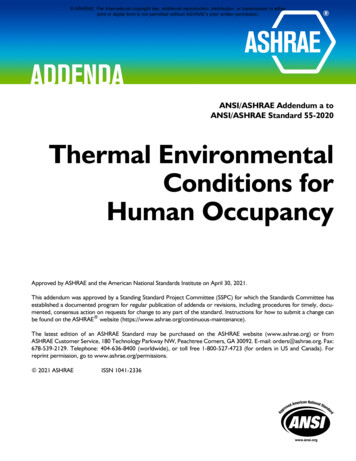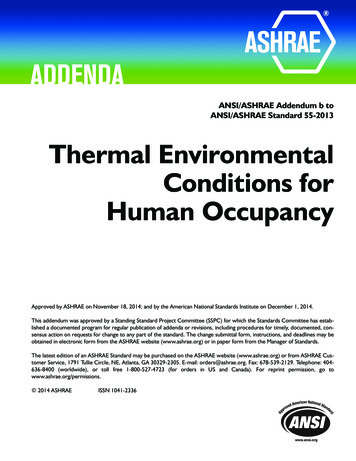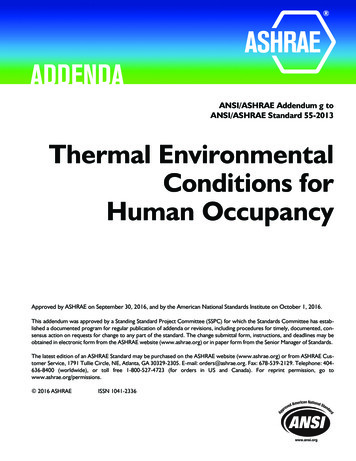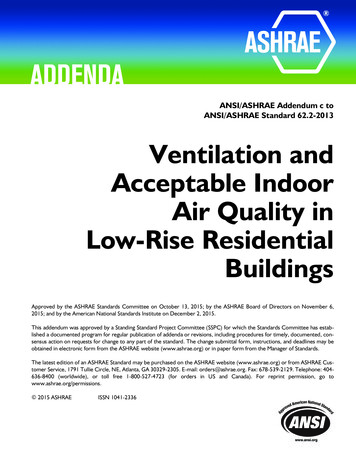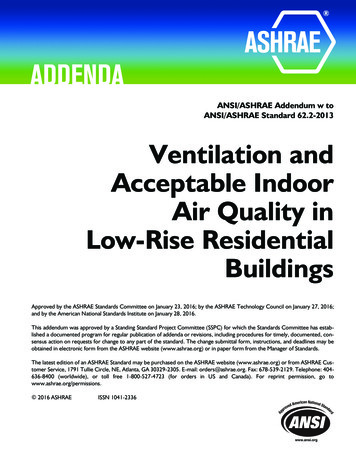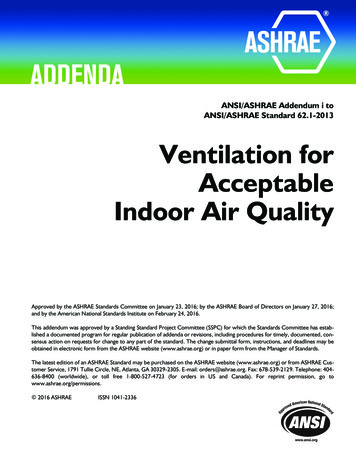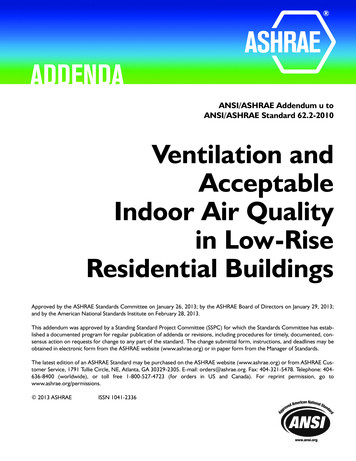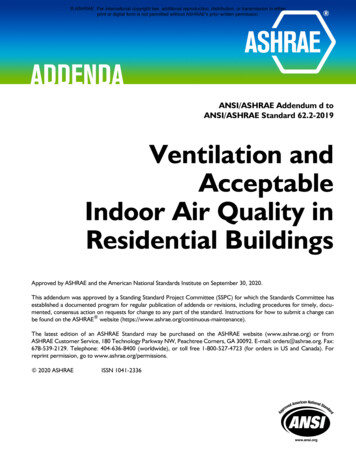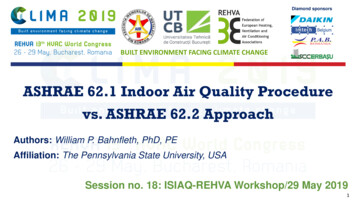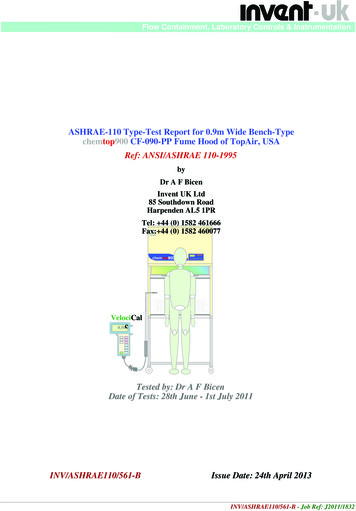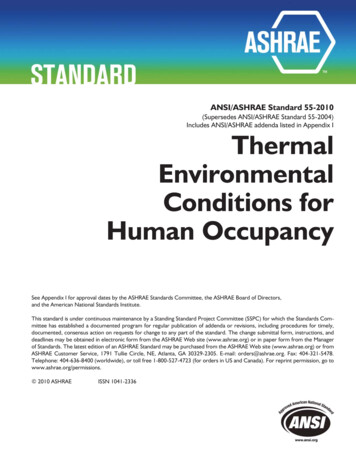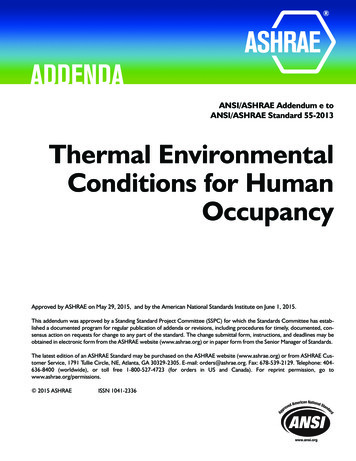
Transcription
ANSI/ASHRAE Addendum e toANSI/ASHRAE Standard 55-2013Thermal EnvironmentalConditions for HumanOccupancyApproved by ASHRAE on May 29, 2015, and by the American National Standards Institute on June 1, 2015.This addendum was approved by a Standing Standard Project Committee (SSPC) for which the Standards Committee has established a documented program for regular publication of addenda or revisions, including procedures for timely, documented, consensus action on requests for change to any part of the standard. The change submittal form, instructions, and deadlines may beobtained in electronic form from the ASHRAE website (www.ashrae.org) or in paper form from the Senior Manager of Standards.The latest edition of an ASHRAE Standard may be purchased on the ASHRAE website (www.ashrae.org) or from ASHRAE Customer Service, 1791 Tullie Circle, NE, Atlanta, GA 30329-2305. E-mail: orders@ashrae.org. Fax: 678-539-2129. Telephone: 404636-8400 (worldwide), or toll free 1-800-527-4723 (for orders in US and Canada). For reprint permission, go towww.ashrae.org/permissions. 2015 ASHRAEISSN 1041-2336
ASHRAE (www.ashrae.org). For personal use only. Additional reproduction, distribution,or transmission in either print or digital form is not permitted without ASHRAE's prior written permission.ASHRAE Standing Standard Project Committee 55Cognizant TC: 2.1, Physiology and Human EnvironmentSPLS Liaison: John F. DunlapGwelen Paliaga,* ChairLawrence J. Schoen,* Vice-ChairPeter F. Alspach,* SecretaryEdward A. Arens*Richard M. Aynsley*Robert Bean*Josh Eddy*Thomas B. Hartman*Essam E. Khalil*Michael P. O’Rourke*Abhijeet Pande*Zaccary A. Poots*Julian Rimmer*Michael Tillou*Stephen C. Turner*Atze BoerstraGail S. BragerRichard de DearMichael A. HumphreysDaniel Int-Hout, IIIThomas LesserBaizhan LiRodrigo MoraStefano Schiavon* Denotes members of voting status when the document was approved for publicationASHRAE STANDARDS COMMITTEE 2014–2015Richard L. Hall, ChairDouglass T. Reindl, Vice-ChairJoseph R. AndersonJames Dale AsweganCharles S. BarnabyDonald M. BrundageJohn A. ClarkWaller S. ClementsDavid R. ConoverJohn F. DunlapJames W. Earley, Jr.Steven J. EmmerichPatricia T. GraefRita M. HarroldAdam W. HingeSrinivas KatipamulaDebra H. KennoyMalcolm D. KnightRick A. LarsonArsen K. MelkovMark P. ModeraCyrus H. NasseriHeather L. PlattPeter SimmondsWayne H. Stoppelmoor, Jr.Jack H. ZarourJulia A. Keen, BOD ExOBjarne Wilkens Olesen, COStephanie C. Reiniche, Senior Manager of StandardsSPECIAL NOTEThis American National Standard (ANS) is a national voluntary consensus Standard developed under the auspices of ASHRAE. Consensus is definedby the American National Standards Institute (ANSI), of which ASHRAE is a member and which has approved this Standard as an ANS, as“substantial agreement reached by directly and materially affected interest categories. This signifies the concurrence of more than a simple majority,but not necessarily unanimity. Consensus requires that all views and objections be considered, and that an effort be made toward their resolution.”Compliance with this Standard is voluntary until and unless a legal jurisdiction makes compliance mandatory through legislation.ASHRAE obtains consensus through participation of its national and international members, associated societies, and public review.ASHRAE Standards are prepared by a Project Committee appointed specifically for the purpose of writing the Standard. The ProjectCommittee Chair and Vice-Chair must be members of ASHRAE; while other committee members may or may not be ASHRAE members, allmust be technically qualified in the subject area of the Standard. Every effort is made to balance the concerned interests on all Project Committees.The Senior Manager of Standards of ASHRAE should be contacted fora. interpretation of the contents of this Standard,b. participation in the next review of the Standard,c. offering constructive criticism for improving the Standard, ord. permission to reprint portions of the Standard.DISCLAIMERASHRAE uses its best efforts to promulgate Standards and Guidelines for the benefit of the public in light of available information and acceptedindustry practices. However, ASHRAE does not guarantee, certify, or assure the safety or performance of any products, components, or systemstested, installed, or operated in accordance with ASHRAE’s Standards or Guidelines or that any tests conducted under its Standards or Guidelineswill be nonhazardous or free from risk.ASHRAE INDUSTRIAL ADVERTISING POLICY ON STANDARDSASHRAE Standards and Guidelines are established to assist industry and the public by offering a uniform method of testing for rating purposes, bysuggesting safe practices in designing and installing equipment, by providing proper definitions of this equipment, and by providing other informationthat may serve to guide the industry. The creation of ASHRAE Standards and Guidelines is determined by the need for them, and conformanceto them is completely voluntary.In referring to this Standard or Guideline and in marking of equipment and in advertising, no claim shall be made, either stated or implied,that the product has been approved by ASHRAE.ASHRAE is a registered trademark of the American Society of Heating, Refrigerating and Air-Conditioning Engineers, Inc.ANSI is a registered trademark of the American National Standards Institute.
ASHRAE (www.ashrae.org). For personal use only. Additional reproduction, distribution,or transmission in either print or digital form is not permitted without ASHRAE's prior written permission.(This foreword is not part of this standard. It is merelyinformative and does not contain requirements necessaryfor conformance to the standard. It has not been processed according to the ANSI requirements for a standardand may contain material that has not been subject topublic review or a consensus process. Unresolved objectors on informative material are not offered the right toappeal at ASHRAE or ANSI.)FOREWORDThis addendum removes permissive language foundthroughout the standard (excluding the title; Sections 1, 2, 3,and 7; and all Informative Appendices). In doing so, valuesfor maximum differences of clothing level and metabolic ratebetween multiple occupants in a zone that allow averaginginto a single representative occupant were established at 0.1met and 0.15 clo. Reference Addendum b to Standard 55-2013that is available for free download on the ASHRAE website ology/standards-addenda.Note: In this addendum, changes to the current standardare indicated in the text by underlining (for additions) andstrikethrough (for deletions) unless the instructions specifically mention some other means of indicating the changes.Addendum e to Standard 55-2013Revise Section 4.1 as follows.4.1 WhenWhere information is required to be identified inthis standard, it shall be documented in accordance with andin addition to the requirements in Section 6.Move the current example from Section 5.2.1.1 into Section4.3 as follows.4.3 For each space type, at least one representative occupantshall be identified. If any known set of occupants is excludedfrom consideration then these excluded occupants shall beidentified.Note: The customers in a restaurant may have a metabolic rate near 1.0 met, while the servers may have a metabolic rate closer to 2.0 met. Per Section 5.2.1.1, each of thesegroups of occupants shall be considered separately in determining the conditions required for comfort. In some situations such as this, it will not be possible to provide anacceptable level or the same level of comfort to all disparategroups of occupants.Modify Section 4.5 as follows.4.5 The thermal environment required for comfort is determined according to in accordance with Section 5 of this standard.Modify Section 5.2.1.1 as follows (the example is moved toSection 4.3 as noted above).5.2.1.1 Rate for Each Representative Occupant. Foreach representative occupant, determine the metabolic rateassociated with the occupant’s activities. Averaged metabolicANSI/ASHRAE Addendum e to ANSI/ASHRAE Standard 55-2013rates shall not be used to represent multiple occupants withsignificantly different metabolic rates whose metabolic ratesdiffer by more than 0.1 met.Example: The customers in a restaurant may have a metabolic rate near 1.0 met, while the servers may have a metabolic rate closer to 2.0 met. Each of these groups ofoccupants shall be considered separately in determiningthe conditions required for comfort. In some situationssuch as this, it will not be possible to provide an acceptable level or the same level of comfort to all disparategroups of occupants.Note: For example, in an office setting, when comparingan occupant who is seated and reading at 1.0 met with anoccupant that is typing at 1.1 met, they can be grouped as asingle representative occupant. If the same seated occupant iscompared to an occupant who is seated and filing at 1.2 met,each shall be considered separately when determining theconditions required for thermal comfort.Modify Section 5.2.1.2 as shown below. The remainder ofSection 5.2.1.2 is unchanged.5.2.1.2 Rate Determination. Use one or a combinationof the following methods to determine metabolic rate:a. Use the data presented in Table 5.2.1.2 for the task mostcomparable to the activity of the representative occupant.Where a range is given, select a single value within thatrange based on the characteristics of the activity.a. Metabolic rates for typical occupant activity types givenin Table 5.2.1.2 shall be used to describe the representative occupant. Where a range is given, select a singlevalue within that range based on characteristics of theactivity. If a proposed occupant activity type is not listedin Table 5.2.1.2, the most similar activity type based oncharacteristics of the activity shall be used.[ ]Modify Section 5.2.1.3 as follows.5.2.1.3 Time-Weighted Averaging. Use a time-weightedaverage metabolic rate for individuals with activities thatvary. Such averaging shall not be applied when where anactivity persists for more than one hour. In that case, two distinct metabolic rates shall be used.Note: For example, Example: a person who spends 30minutes out of each hour “lifting/packing,” 15 minutes “filing, standing,” and 15 minutes “walking about” has an average metabolic rate of 0.50 2.1 0.25 1.4 0.25 1.7 1.8 met. However, a person who is engaged in “lifting/packing” for more than one hour and then “filing, standing” formore than one hour shall be treated as having two distinctmetabolic rates per Section 5.2.1.1.Modify Section 5.2.2.1.2 as follows.5.2.2.1.2 Averaged clothing insulation (Icl) shall not beused to represent multiple occupants with significantly different clothing insulation whose clothing insulation differs bymore than 0.15 clo.1
ASHRAE (www.ashrae.org). For personal use only. Additional reproduction, distribution,or transmission in either print or digital form is not permitted without ASHRAE's prior written permission.TABLE 5.3.1 Applicability of Methods for Determining Acceptable Thermal ConditionsEnvironments in Occupied SpacesAverage Air Speed,m/s (fpm)Humidity Ratio 0.20 (40)MetCloComfort Zone Method 0.012 kg·H2O/kg1.0 to 1.3dry air0.5 to 1.0Section 5.3.1, “Graphic Comfort Zone Method” 0.20 (40)All1.0 to 2.00 to 1.5Section 5.3.2, “Analytical Comfort Zone Method” 0.20 (40)All1.0 to 2.00 to 1.5Section 5.3.3, “Elevated Air Speed Comfort ZoneMethod”Modify Section 5.2.2.2 as follows.5.2.2.2 Insulation Determination. Use one or a combination of the following methods to determine clothing insulation (Icl):a. Use the data presented in Table 5.2.2.2A for the expectedensemble of each representative occupant.b. Add or subtract the insulation (Iclu) of individual garmentsin Table 5.2.2.2B from the ensembles in Table 5.2.2.2A todetermine the insulation of ensembles not listed.c. Determine a complete clothing ensemble using the sum ofthe individual values listed for each item of clothing in theensemble in Table 5.2.2.2B.d. It is permitted, but not required, to adjust any of the aboveprevious methods for seated occupants using Table5.2.2.2C.e. For moving occupants, it is permitted but not required toadjust any of the above previous methods using the following formula:Icl, active Icl (0.6 0.4/M)1.2 met M 2.0 metwhere M is the metabolic rate in mets and Icl is the insulation without movement.f. Interpolate between or extrapolate from the values givenin Tables 5.2.2.2B and 5.2.2.2C.g. Use Figure 5.2.2.2 to determine the clothing insulation(Icl) of a representative occupant for a day as a function ofoutdoor air temperature at 06:00 a.m., ta(out,6).Exception: The cClothing insulation (Icl) determinedaccording to in accordance with Figure 5.2.2.2 may be ispermitted but not required to be adjusted to higher orlower values to account for unique dress code or culturalnorms using other methods in Section 5.2.2.2 or approvedengineering methods.h. Use measurement with thermal manikins or otherapproved engineering methods.Modify Section 5.3 as follows.5.3 General Method for Determining Acceptable Thermal Conditions Environment in Occupied Spaces. Section5.3 is permitted to be used to determine the requirements forthermal comfort in all occupied spaces within the scope ofthis standard.Acceptable thermal conditions environments shall bedetermined using one of the three methods shown in Table25.3.1 and any applicable requirements of Sections 5.3.4 and5.3.5.Note: Average air speed and average air temperaturehave precise definitions in this standard. See Section 3.0 forall defined terms.Modify Section 5.3.3 as follows.5.3.3 Elevated Air Speed Comfort Zone Method. Figure5.3.3A represents two particular cases of the Elevated AirSpeed Comfort Zone Method and shall be permitted as amethod of compliance for the conditions specified on the figure. It is permissible to determine the acceptable operativetemperatur
21.05.2015 · ANSI/ASHRAE Standard 55-2013 Thermal Environmental Conditions for Human Occupancy Approved by ASHRAE on May 29, 2015, and by the American National Standards Institute on June 1, 2015. This addendum was approved by a Standing Standard Project Committee (SSPC) for which the Standards Committee has estab-lished a documented program for regular publication of addenda or

